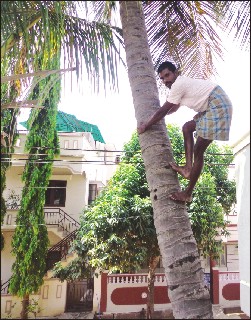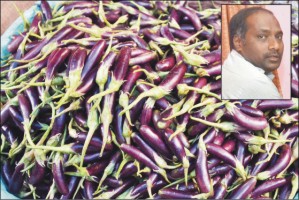
by Phalgunn Maharishi
Marakke naanu hedralla buddhi! Ave nange hedrathve” (I am not afraid of trees Sir! But they are afraid of me), is what one would frequently hear from Ravi, a young lad of 27 years, who comes all the way from Kalanhundi village of Chamarajnagar district to Mysore every day early in the morning and work in the city plucking tender coconuts from trees, gardening, washing vehicles, cleaning homes and also driving cars when needed.
Truly, a multi-faceted personality is what best describes Ravi who is popularly known among his regular customers as “Theng Ravi” (Coconut Ravi). He climbs nearly 80 trees every day to pluck tender coconuts. He has a long list of regular customers in Mysore and some in Bangalore too who wait for him to get tender coconuts plucked from their trees.
While speaking about when and how he entered into the profession, Ravi said, “I was in my 7th grade when I had come out of the exam hall with a blank answer sheet making a firm decision of quitting my studies. My parents then started forcing me to learn something to lead my life and hence, I learnt what my father was doing.” Yes! Ravi’s father was in the same profession; plucking tender coconuts and selling them. But Ravi is for sure a hand more than his father!
Ravi started climbing trees when he was just 15 years. He cannot read and write, yet his style of picking the phone and talking with his customers in Kannada with some English words added here and there, fixing appointments, working on first come-first serve basis and finally postponing some of his works for a day or two due to insufficient time, surely makes our lower jaws go lower! A person hailing from a village without education managing his profession so neatly in cities like Mysore and Bangalore is something really applaudable.
But that’s not it for Ravi. From his hard earned money through his profession, Ravi has recently joined hands with his friend and started agriculture in a five acre land on contract basis near the borders of Tamil Nadu. Ravi also helps his father Basavanna in cultivating their ancestral property near Kalanhundi village. Ravi is married to a supportive wife and blessed with a daughter recently. He has enough from his ancestors to lead his life peacefully, yet he believes in sweating hard and earning bread for himself and his family.
“Eight years ago, I came to Mysore for the first time to find some work. I had then turned my back with an empty hand and a sad face and started stepping towards the railway station. But then, a person from Ashokpuram approached me to pluck coconuts from a tree in his home. Later on, my profession slowly developed as days passed and today, a big list of my regular customers has been developed!”, commented Ravi while explaining his experiences when he started his work in the city. He then added, “Now people call me to fix their taps, clean their sumps and compounds, drive their cars, paint walls, cementing floors, along with plucking tender coconuts. They have made me an ALL-IN-ONE. And I am happy.”
Ravi is not just a magnificent worker who pours his sweat in the hot sun but also a fine artiste on stage who entertains residents of his village and the nearby people. He owes his talent of acting to his Guru, Shri Shivakumara Swamy of his village, with whom he has joined hands from 2007. Ravi, along with the group ‘Sri Basaveshwara Kala Sangha,’ has staged plays in front of thousands of villagers. He has acted as an antagonist in plays like Bhoomi Thookada Hennu and Thande Thaayi Aththige to name a few.
“I act in theatre because it is a refreshment which blows away my worries and headaches which I face whole day climbing trees and plucking tender coconuts in the hot sun. I enjoy entertaining the viewers,” said Ravi while speaking about his hobby of acting in theatre. He also added, “We are a group of twelve people who are from various professions who join together with our Guruji, select a novel and practice it for nearly two months and then present it in front of the people in our villages. A big gathering can be seen who enjoy our acts.”
Ravi even commented that he, along with his group mates, bares expenditures of the shows they act and present and the only returns they get is through the desired amount given to them by the viewers. Such hard working village people like Theng Ravi who are trying to keep alive the art of theatre acting even in their villages are in need of more encouragement by the people and the government.
source: http://www.starofmysore.com / Star of Mysore / Home> Feature Articles / April 15th, 2014






